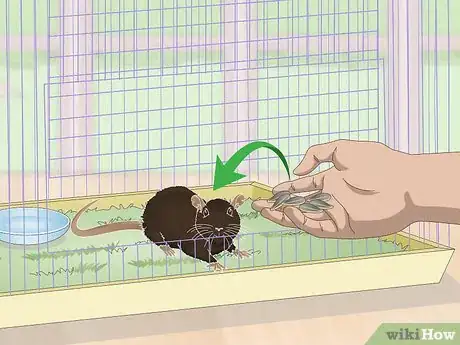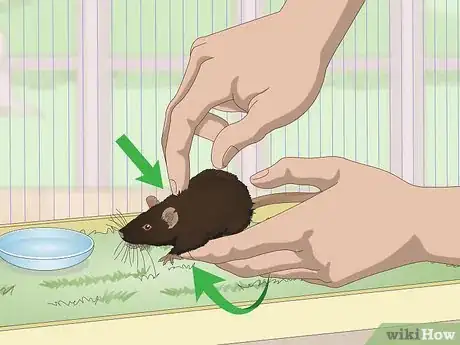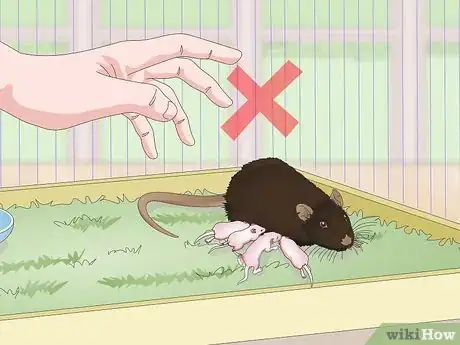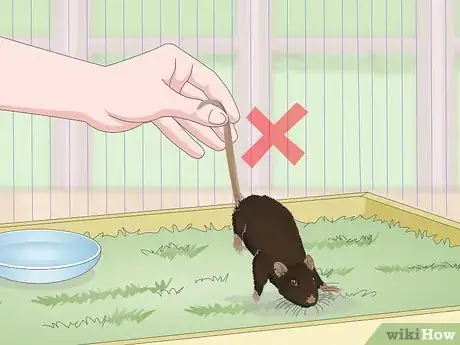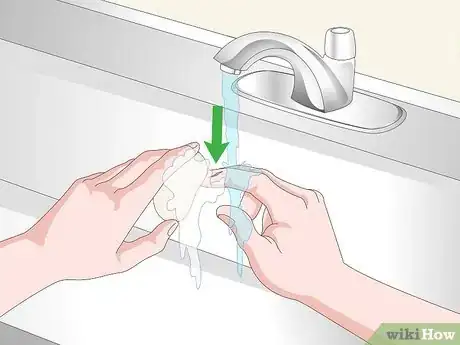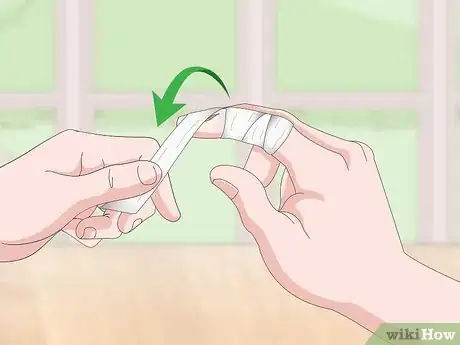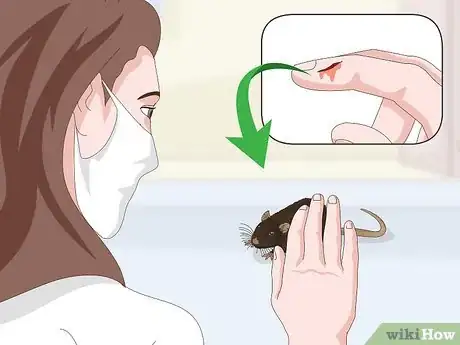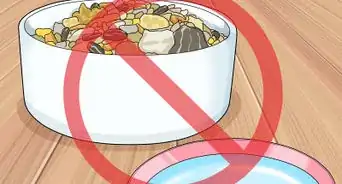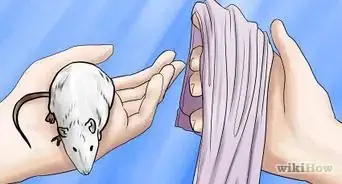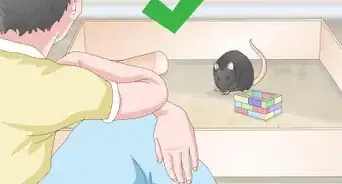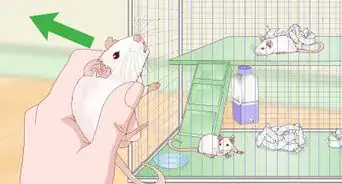This article was co-authored by Pippa Elliott, MRCVS. Dr. Elliott, BVMS, MRCVS is a veterinarian with over 30 years of experience in veterinary surgery and companion animal practice. She graduated from the University of Glasgow in 1987 with a degree in veterinary medicine and surgery. She has worked at the same animal clinic in her hometown for over 20 years.
This article has been viewed 16,956 times.
Mice are generally friendly and docile pets. However, under certain circumstances, they may be inclined to bite or scratch their owners. While mice are unable to do any serious damage to a person’s skin, the bites and scratches can still be painful, especially for children. If you have a pet mouse that bites or scratches on occasion, you can socialize it to stop it from biting, or interact with it at certain times when it’s less likely to bite.
Steps
Socializing Your Mouse
-
1Spend time around your mouse in its cage. If you’ve just brought home a new mouse, it will most likely be stressed, since its entire environment is new. Before you begin handling a new mouse, try to spend time near it. This also applies if you’re dealing with a mouse that you’ve owned for months or years but have not previously socialized. Spending time near your mouse will help it get used to your smell and the sound of your voice, and will greatly decrease the likelihood of your mouse biting you. Speak softly to your mouse, and move slowly while your mouse is still getting used to your presence.[1] You—and your children—can also:
- Read or do homework in the room with your mouse’s cage.
- Quietly watch TV near your mouse’s cage.
- Bring your mouse (in its cage) into the family room while you play a quiet game.
-
2Place treats in the cage 2 or 3 times a day to help socialize your mouse. You need to socialize your mouse so that it’s used to your presence and your touch, and won’t bite or scratch you out of fear. When you first bring it home—or when you decide to start socializing a previously un-socialized mouse—leave your mouse in its cage for a few days. Then, introduce your mouse to your smell, and to being near your body, by setting a couple of small treats in your mouse’s cage. Remove your hand once you’ve set the treats down, or your mouse may be too afraid to eat them.[2]
- You can give a mouse sunflower seeds or raisins as a treat. Or, use small pieces of fruit (like half of a blueberry) as treats. Offer the treat on a wooden spoon and praise your mouse when it takes the treat. This helps associate your voice with good things and rewards.
- If your children will be your mouse’s primary caretakers, encourage them to be the ones to offer your mouse treats and to begin to socialize it.
Advertisement -
3Stroke and pick up your mouse. After the third or fourth day on which you’ve given your mouse treats, you can begin to touch it. At first, use a couple of fingers to touch and stroke your mouse’s back. Once it seems comfortable with this amount of contact, gently scoop your mouse up into the palm of your hand. Continue to pet it, and return it to its cage after about 5 minutes.[3]
- Be sure to handle your mouse safely by always holding it in a closed room and keeping it near the floor in case it jumps from your hand.
- Move slowly when handling your mouse, and never reach out and abruptly grab it. Encourage your children to do the same.
-
4Handle your mouse every day to keep it socialized. Pet mice should be used to being handled by both adults and children. Your mouse will quickly learn that humans pose no threat, and consequently your mouse will be relaxed and not feel like it must defend itself when touched by people. However, if a mouse is neglected or doesn’t get handled often, it may bite or scratch people as a means of self-defense.[4]
- Once your mouse has become comfortable with its handlers, you can increase the length of time you hold it. Some mouse owners like to stroll around their house holding their mouse.
- If you’ve been away for an extended period of time (e.g., a month-long vacation) and your mouse seems uncomfortable with being handled upon your return, you may need to begin the socialization process over again.
-
5Adopt a second female mouse to keep a female mouse calm. Mice are social creatures and are most comfortable in pairs or groups. While most mice are satisfied to socialize with humans, some prefer being around other mice. If your pet mouse generally seems irritable and has a tendency to bite or scratch when picked up, try adopting a second mouse and keeping them in the same cage. It’s likely that the presence of a second mouse will calm down the first mouse, and decrease its aggression towards humans.[5]
- While female mice do well when kept in a cage together, unneutered male mice do not. They tend to fight. You can have your male mice neutered to prevent this problem.
- If you keep male and female mice in a cage together, it’s very likely that they’ll have babies.
Handling Your Mouse Safely
-
1Handle your mouse when it’s calm and doesn’t feel frightened. In general, a mouse will bite or scratch a human in situations where it feels frightened. Its natural “fight or flight” instinct will kick in, and it may try to defend itself. So, only handle your mouse when it’s calm and feels safe. You can tell that your mouse feels stressed if it’s huddling in a corner of the cage or is standing motionless. A mouse may feel frightened if:
- It’s in a loud environment. For example, if there are 6–7 people in the room with its cage.
- A cat or other predatory animal is in the room.
- A person tries to grab it or handle it roughly.
-
2Do not handle a female mouse shortly after it gives birth. As with any mammal, female mice can be fiercely protective of their newly born young. If you try to pet a mother mouse, she may feel as if you’re threatening her pups, and bite or scratch you to defend them. If you must handle the mother after she’s given birth, move slowly and do not touch the pups.[6]
- If your children are your mouse’s primary caretakers, explain to them that they shouldn’t try to separate the mother mouse from her pups.
-
3Wash your hands before petting your mouse. If you or your kids pet or handle a mouse shortly after you’ve eaten a meal, your mouse may smell the food on your hands and decide to take a bite, hoping to get a mouthful of tasty food. While this isn’t a sign of aggression or hostility, it can still hurt. So, always wash your hands before handling your mouse.[7]
- Since mice rarely eat meat, they’ll be most likely to bite you if your hands smell like fresh fruit or grains (like oatmeal).
-
4Never pick your mouse up by its tail. The tails of mice are sensitive, and it will cause your mouse pain and stress if you lift it by the tail (especially if you hold the tail by its tip). When it’s under stress and in pain, your mouse will likely try to bite or scratch you out of self-defense. To avoid being bitten, always hold a mouse by cupping it in your palm.[8]
- If your children frequently handle your mouse, let them know that it will hurt and scare your mouse if they pick it up by the tail.
-
5Do not shout at or strike your mouse if it bites you. A mouse bite can be surprising and painful, but you shouldn’t react with anger towards your mouse. If your mouse bites or scratches you, return your mouse to its cage as quickly as possible and go clean the wound. Mice bite when they feel threatened, not out of feelings of anger or malice. If you shout at your mouse, hit it, or throw it across the room, you may permanently ruin any chance of your mouse coming to trust you.
- Not to mention, a sharp blow or fast toss across a room may be fatal to a mouse.
Caring for Bites and Scratches
-
1Clean the wound by washing with soap and water. Firm bites and hard scratches from your mouse can be painful. If your mouse sinks its teeth or nails into your hand or arm, wash the location in your sink. Rub a standard soap on the wound until it’s covered in lather, and rinse the area with lukewarm water.[9]
- Dry the wound with a paper towel, so you can throw it away if a little blood gets on the material.
-
2Cover the wound with a bandage if the bite or scratch broke your skin. Once the wound has dried, rub a small dollop of antibiotic cream on the wound. Then cover it with a clean bandage.[10] Since scratches and bites from mice are typically small, a Band-Aid should work to cover up the wound.
- If your mouse bites you but doesn’t break the skin, a bandage is unnecessary. Be sure to still wash the scratch, though.
- You can purchase an antibiotic cream at a local drug store or pharmacy.
-
3Take your mouse to your vet if a bite breaks your skin. Mice very rarely carry rabies. However, if a bite from your mouse breaks the skin and draws blood, take your mouse to the veterinarian immediately. The vet can test the animal for rabies, and confirm that it doesn’t have the disease.[11]
- If the test comes back negative, you’ll be able to take your mouse back home with you. A positive test will mean that your mouse must be euthanized. Although it may be sad to lose your pet, this is the most humane option for your mouse.
References
- ↑ http://animals.mom.me/tame-mouse-got-pet-store-1232.html
- ↑ http://animals.mom.me/pet-mice-bite-1512.html
- ↑ http://animals.mom.me/pet-mice-bite-1512.html
- ↑ http://animals.mom.me/pet-mice-bite-1512.html
- ↑ https://www.research.psu.edu/arp/experimental-guidelines/rodent-behavioral-tests-1/social-and-aggressive-behaviors-in-rodents.html
- ↑ http://animals.mom.me/pet-mice-bite-1512.html
- ↑ http://animals.mom.me/pet-mice-bite-1512.html
- ↑ http://animals.mom.me/tame-mouse-got-pet-store-1232.html
- ↑ https://www.mayoclinic.org/first-aid/first-aid-animal-bites/basics/art-20056591

